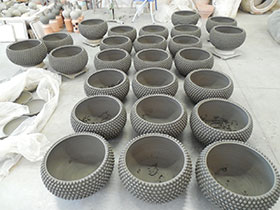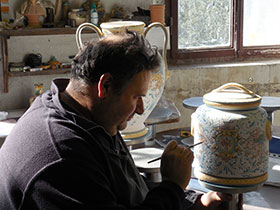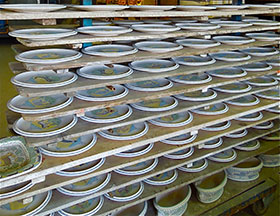Montelupo Fiorentino
 Montelupo Fiorentino is a tourist destination for all who seek hand-painted Tuscan ceramics. It is the center of Italian pottery, or maiolica, production in the region and has been since before the Renaissance. Montelupo is located at the Pesa and Arno rivers’ confluence, just a few miles west of Florence. The area is rich in two components fundamental to pottery: plentiful clay sediments and forests full of hardwood and underbrush for the firing. Archeological excavations have found fragments of pottery dating back to the pre-Etruscan time.
Montelupo Fiorentino is a tourist destination for all who seek hand-painted Tuscan ceramics. It is the center of Italian pottery, or maiolica, production in the region and has been since before the Renaissance. Montelupo is located at the Pesa and Arno rivers’ confluence, just a few miles west of Florence. The area is rich in two components fundamental to pottery: plentiful clay sediments and forests full of hardwood and underbrush for the firing. Archeological excavations have found fragments of pottery dating back to the pre-Etruscan time.
The Florentines built a castle in Montelupo, Castello di Montelupo, in the early 13th century to defend the Arno River from Pisa, their eternal enemy. The animosity between the two powers was so strong that by the early 16th century, Niccoló Macchiavelli, an administrator responsible for the Florentine military and foreign policy, collaborated with Leonardo Da Vinci to divert the Arno River. Thus, depriving Pisa of water and access to the Sea.
The project was never completed, but the attempt shows the level of rancor felt between the city-states. Montelupo eventually grew from being a defensive outpost to a small village. Then, it grew into a town with a flourishing culture surrounding the making of pottery. Thus, it became one of the most important ceramic centers of the Italian peninsula.
 The end of the 15th and the beginning of the 16th century represent a wondrous Italian majolica period. The most significant sites for pottery making were Faenza, Siena, Deruta, Castel Durante (now Urbania), and Cafaggiolo. The starting point occurred in the late 15th century when a group of 23 Vasai potters from Montelupo, led by Piero and Stefano Di Filippo, signed a contract for eight years with Francesco Antinori, a Florentine nobleman.
The end of the 15th and the beginning of the 16th century represent a wondrous Italian majolica period. The most significant sites for pottery making were Faenza, Siena, Deruta, Castel Durante (now Urbania), and Cafaggiolo. The starting point occurred in the late 15th century when a group of 23 Vasai potters from Montelupo, led by Piero and Stefano Di Filippo, signed a contract for eight years with Francesco Antinori, a Florentine nobleman.
The contract required they move ceramics production to the Castle of Cafaggiolo on the hills north of Florence, a beautiful estate belonging to the Medici family, later transformed into a magnificent villa by the architect, Michelozzo Michelozzi. The Medici owned Cafaggiolo until their last member, Giangastone, died in 1737.
Some of the original 23 Vasai and their families remained in Cafaggiolo, while some returned to Montelupo with their newfound craft. Piero and Stefano Di Filippo split their time between the two places. The experience at Cafaggiolo improved the pottery quality made in Montelupo a great deal, raising it to the highest level of quality that remains to this day. Montelupo is still a center of ceramic making. Even the street signs are made of majolica.
 We are delighted to carry pieces from quite a few artisans, masters of the craft, who often work side by side with the next generation in the family. A prime example is that of N.D. Dolfi. His daughters, Natalia and Daria, have certainly inherited the genius of Silvano Dolfi. They, along with Natalia’s husband, Carlo, create some of the most extraordinary ceramics available anywhere.
We are delighted to carry pieces from quite a few artisans, masters of the craft, who often work side by side with the next generation in the family. A prime example is that of N.D. Dolfi. His daughters, Natalia and Daria, have certainly inherited the genius of Silvano Dolfi. They, along with Natalia’s husband, Carlo, create some of the most extraordinary ceramics available anywhere.
Silvano’s father, Giovanni Dolfi, started the workshop in the 1940s. It was subsequently successfully run by his son, Silvano Dolfi, who garnered a strong reputation for his ceramics in both the United States and Italy. His love and mastery of the craft, his desire to experiment with new shapes and forms, and his respect for traditions are the foundations of his success. Though we miss him and his vitality and humor, we celebrate the continuing excellence of the product that comes from his workshop. We are proud to call his widow, Lucia, and his wonderful family, our friends.
We have been working with the masterful Ceramiche d’Arte Tuscia since the 1980s. Their creativity and talent have brought to our selection some favorites. The work, the artists, produces is a tribute to a tradition passed down generations. Ceramiche Marino Di Pallanti Marzia, or “Marino,” is a family of some of Ceramica’s most talented artisans. Their ceramics reveal some of the most skillfully detailed hand-painted designs that have become favorites of ours.
Finally, we most recently started working with Ceramiche Mori. The colors and designs they produce are some of the most vibrant and beautiful. Their skillfully hand-painted pieces pay tribute to Tuscan tradition. In every case, the artisan’s skill has been passed down through their family as maiolica is a tradition that dates back centuries.

